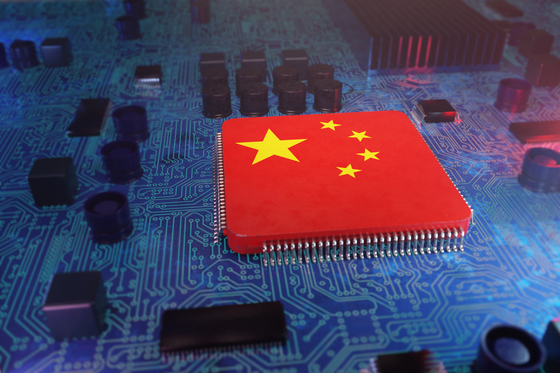China winning in down-market chips

The author is a Beijing correspondent of the JoongAng Ilbo.
Korea has incurred a deficit in trade with China for the first time since August 1994. According to the Korea Customs Service, exports to China in May totaled $13.4 billion, while imports reached $14.9 billion to cause a deficit of $1.1 billion. The red has already stretched to $600 million in the first 10-day trade this month. For the first time since the normalization of relations between the two countries, the surplus end has changed.
Korea International Trade Association (KITA) Beijing branch has embarked on an examination of the alarming turnaround. Of Korea imports from China, 16.5 percent were semiconductors, 10.3 percent precision chemicals and 5.5 percent computers. Chip imports from China in May totaled $2.4 billion, up 40.9 percent on year. Chips were also Korea’s top export to China, but Korea’s chip imports from China have grown four times faster, contributing to the deficit. What has caused such change?
China has been going all-out to localize chipmaking technology amid U.S. containment. It has been as eager with semiconductors as with its nuclear, thermonuclear weapons and satellite developments in the late 1960s. While announcing the “Made in China 2025” roadmap in 2015, Beijing prioritized next-generation IT and semiconductor technology among its 10 strategic industries and created a national chip fund. According to the China Semiconductor Industry Association (CSIA), the Chinese government provided 138.7 billion yuan ($20.8 billion) to its top 50 chipmakers and designers through 2019. In a five-year plan announced in 2020, Beijing pledged chip funding of 204.1 billion yuan. China’s State Council — the country’s top executive body — vowed 1 trillion yuan in chip funding through 2025.

The chip industry has rapidly changed as a result. First, China’s chip design, or fabless technology, has been advancing fast. According to Taiwanese market researcher TransForce’s ranking for the first quarter, published on June 9, China’s Will Semi ranked No. 9 in the global chip design market nearly on par with such majors as Qualcomm, NVIDIA, Broadcom and AMD for the first time. Will Semi specializes in designing complementary metal-oxide semiconductors (CMOS) for image sensors.
The fabless industry is ascending rapidly in China due to strong demand. There are over 1,600 chip design houses in China. They design not just chips of 14-or-under nanometer class CPUs for computers or application processors for mobile phones but also various types of chips for other functions. They focus on mass-market chip designs to meet the demand for a diverse range of chips.
Second, Chinese players are seeking economies of scale in budget chips. Samsung Electronics and Taiwan’s TSMC are vying in next-gen chips of the 3-nanometer class. But China’s top foundry player SMIC has only one 14-nanometer class fabless plant in Shanghai. Their mainstay is in chips of 28-or-over nanometer class. They cannot migrate to chips of higher performance due to the U.S. ban on ASML exporting to China its extreme ultraviolet radiation (EUV) equipment — essential to inscribing tiny circuits on chips — beyond the 7-nanometer class.
SMIC had to turn to more mass-market chips that do not require sophisticate foreign equipment, which helped bolster its financial performance. China produced 359.4 billion chips last year, jumping 33.3 percent on year. According to the Semiconductor Equipment and Materials International (SEMI), China was the biggest buyer of semiconductor production equipment for two straight years. Last year, it imported $29.6 billion worth, although they were not in the most advanced form. The Bloomberg observed that the surge in China’s chip production capacity will translate into greater global reliance on Chinese supply.
Ko Young-hwa, a researcher at the Center for Korean Peninsula Studies at Peking University, pointed out that since there were over 70,000 chip-related companies in China, Korea will be buying more chips from China than selling. “It is the typical result of China’s human wave attack,” said Ko. Korea must study the status quo of Chinese companies, as it lacks understanding of the Chinese chip power.
Third, China is deemed highly competitive in machine deep-learning AI chips necessary for biometric and voice applications as a result of the Chinese technology development.
Amid the Covid-19 pandemic, China has enhanced facial recognition function of CCTVs and thermal cameras. It also has advanced the sensor technology to detect obstacles for self-driving vehicles. Since it cannot catch up with Intel or Qualcomm in CPU design or Samsung Electronics in memory chipmaking, China targeted a niche market for the future.
According to Lee Woo-keun, a professor of nano and micro mechanics at Tsinghua University, China can hit a jackpot in sensors and AI chips thanks to its enormous investment in the sector. “Korea must pay heed to the development in the semiconductor front in China as local universities have been investing heavily to groom talents, which could be China’s future advantage,” he stressed.










with the Korea JoongAng Daily
To write comments, please log in to one of the accounts.
Standards Board Policy (0/250자)